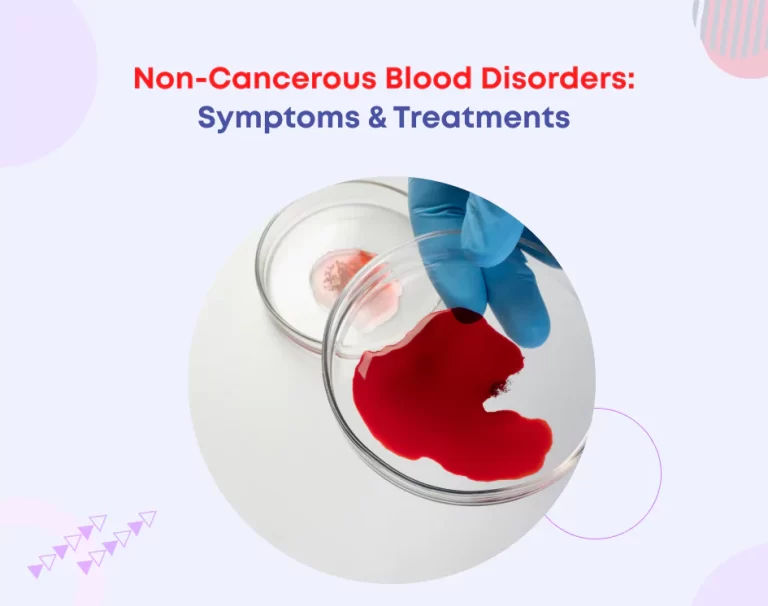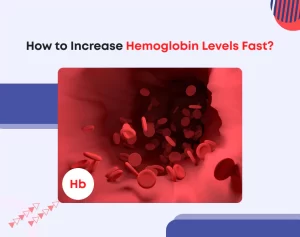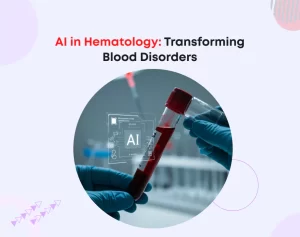
Non-Cancerous Blood Disorders: Symptoms & Treatments
Blood disorders can impact people in different ways, from mild symptoms to more serious, life-threatening issues. While some blood disorders are connected to cancer, others aren’t. However, even non-cancerous blood disorders can last a lifetime, and managing the symptoms is important for staying healthy.
This blog post will explore some of the most common non-cancerous blood disorders, their symptoms, causes, and treatment options.
Non-Cancerous Blood Disorders
Some of the most common non-cancerous blood disorders are:
- Anemia
- Thrombocytopenia (Low Platelet Count)
- Hemophilia
- Sickle Cell Disease
- Polycythemia Vera
- Thalassemia
- Vitamin B12 Deficiency Anemia
- Aplastic Anemia
- Iron Deficiency Anemia
- Idiopathic Thrombocytopenic Purpura (ITP)
Even though non-cancerous blood disorders aren’t cancer, they cause problems like anemia (when you don’t have enough red blood cells), issues with blood clotting (because of low platelets), or abnormal blood cell production and can have serious health issues if left untreated.
With the proper treatment and care, many people can manage these issues and avoid complications, helping them feel better and live more normally.
Common Types of Non-Cancerous Blood Disorders
1. Anemia
Anemia is one of the most common non-cancerous blood disorders. It occurs when there are not enough red blood cells or when the red blood cells lack sufficient hemoglobin, the protein that carries oxygen. This lack of oxygen in the body can result in symptoms such as fatigue, weakness, dizziness, pale skin, and shortness of breath.
Causes of Anemia
Iron deficiency: The most common cause, leading to a reduction in red blood cell production.
Vitamin deficiencies: A lack of vitamin B12 or folic acid can interfere with red blood cell production.
Chronic diseases: Conditions like kidney disease or inflammatory disorders can affect red blood cell production.
Blood loss: Heavy menstrual periods, gastrointestinal bleeding, or surgery can lead to anemia.
Treatment
- Iron supplements for iron-deficiency anemia.
- Vitamin B12 or folic acid supplements for vitamin deficiency-related anemia.
- Medications to stimulate red blood cell production, such as erythropoiesis-stimulating agents.
- Blood transfusions may be needed in severe cases.
2. Platelet Disorders (Thrombocytopenia)
Platelets are essential for blood clotting, and when their levels are too low, it can lead to easy bruising, prolonged bleeding, and an increased risk of hemorrhage. Thrombocytopenia, or low platelet count, is one such disorder.
Causes of Thrombocytopenia
- Autoimmune diseases (e.g., lupus) cause the body to attack its platelets.
- Viral infections like hepatitis or HIV can reduce platelet production.
- Certain medications, including chemotherapy and antibiotics, may interfere with platelet production.
- Bone marrow disorders that affect platelet production.
Symptoms
- Unexplained bruising
- Frequent nosebleeds
- Prolonged bleeding from cuts
- Small, red, or purple spots that appear on the skin due to tiny blood vessels under the skin breaking.
Treatment
- Corticosteroids suppress the immune system if the cause is autoimmune.
- Platelet transfusions to increase platelet counts in severe cases.
- Immunoglobulin therapy in certain autoimmune cases.
- Treating the underlying cause, such as stopping medications that affect platelets or managing an infection.
3. Hemophilia
Hemophilia is a rare genetic disorder that impairs the blood’s ability to clot properly. People with hemophilia can experience spontaneous bleeding or prolonged bleeding from injuries, as their bodies cannot produce enough clotting factors.
Causes of Hemophilia
- Genetic mutations: Hemophilia is inherited, typically affecting males more than females.
- A deficiency causes it in one of the blood clotting factors (Factor VIII in Hemophilia A, Factor IX in Hemophilia B).
Symptoms
- Unexplained or excessive bruising
- Joint pain and swelling from internal bleeding
- Bleeding that does not stop after cuts or injuries
- Blood in urine or stool
Treatment
- Clotting factor replacement therapy: Regular infusions of clotting factor proteins.
- Desmopressin for mild forms of hemophilia stimulates the release of clotting factors.
- Preventive care to avoid injuries and bleeding episodes.
4. Sickle Cell Disease
Sickle cell disease is an inherited blood disorder that causes red blood cells to become rigid and shaped like a crescent or sickle. This abnormal shape can block blood flow, leading to pain and potential organ damage.
Causes of Sickle Cell Disease
They are inherited from both parents who carry the sickle cell trait (autosomal recessive inheritance).
Symptoms
- Pain episodes (crises), especially in the bones and joints.
- Swelling in the hands and feet.
- Frequent infections due to spleen damage.
- Fatigue and pallor.
Treatment
- Pain management during crisis episodes.
- Hydroxyurea to reduce the frequency of pain episodes.
- Blood transfusions are used to boost the number of healthy red blood cells.
- Bone marrow or stem cell transplants in severe cases.
5. Polycythemia Vera
Polycythemia vera is a blood disorder where the body produces too many red blood cells, leading to thickened blood, which can increase the risk of clotting and cause complications such as strokes or heart attacks.
Causes of Polycythemia Vera
JAK2 gene mutation causes the bone marrow to produce excessive red blood cells.
Symptoms
- Headaches and dizziness
- Itchy skin, especially after a warm bath
- Reddened or flushed complexion
- Fatigue and weakness
- Increased risk of blood clots
Treatment
- Phlebotomy (blood removal) to decrease red blood cell levels.
- Aspirin to reduce the risk of clotting.
- Chemotherapy or interferon therapy to reduce blood cell production.
6. Thalassemia
Thalassemia is a genetic disorder that causes abnormal hemoglobin production, leading to anemia. Depending on the type of thalassemia (alpha or beta), people with thalassemia may experience mild to severe anemia.
Causes of Thalassemia
Inherited mutations in the genes responsible for hemoglobin production.
Symptoms
- Fatigue and weakness
- Pale or jaundiced skin
- Bone deformities, especially in the face and skull
- Slow growth in children
Treatment
- To replace red blood cells, regular blood transfusions are done.
- Iron chelation therapy removes excess iron from the body, accumulating from frequent blood transfusions.
- Bone marrow transplant in severe cases.
Take Away
Non-cancerous blood disorders can significantly impact a person’s quality of life, but with early diagnosis and proper treatment, many of these conditions are manageable. Advances in medical care have made it possible to control symptoms and reduce complications. If you experience any symptoms of a blood disorder, such as unexplained fatigue, bruising, or abnormal bleeding, it’s important to consult with a healthcare provider for a proper diagnosis and treatment plan. For better care and support, give us a call.






